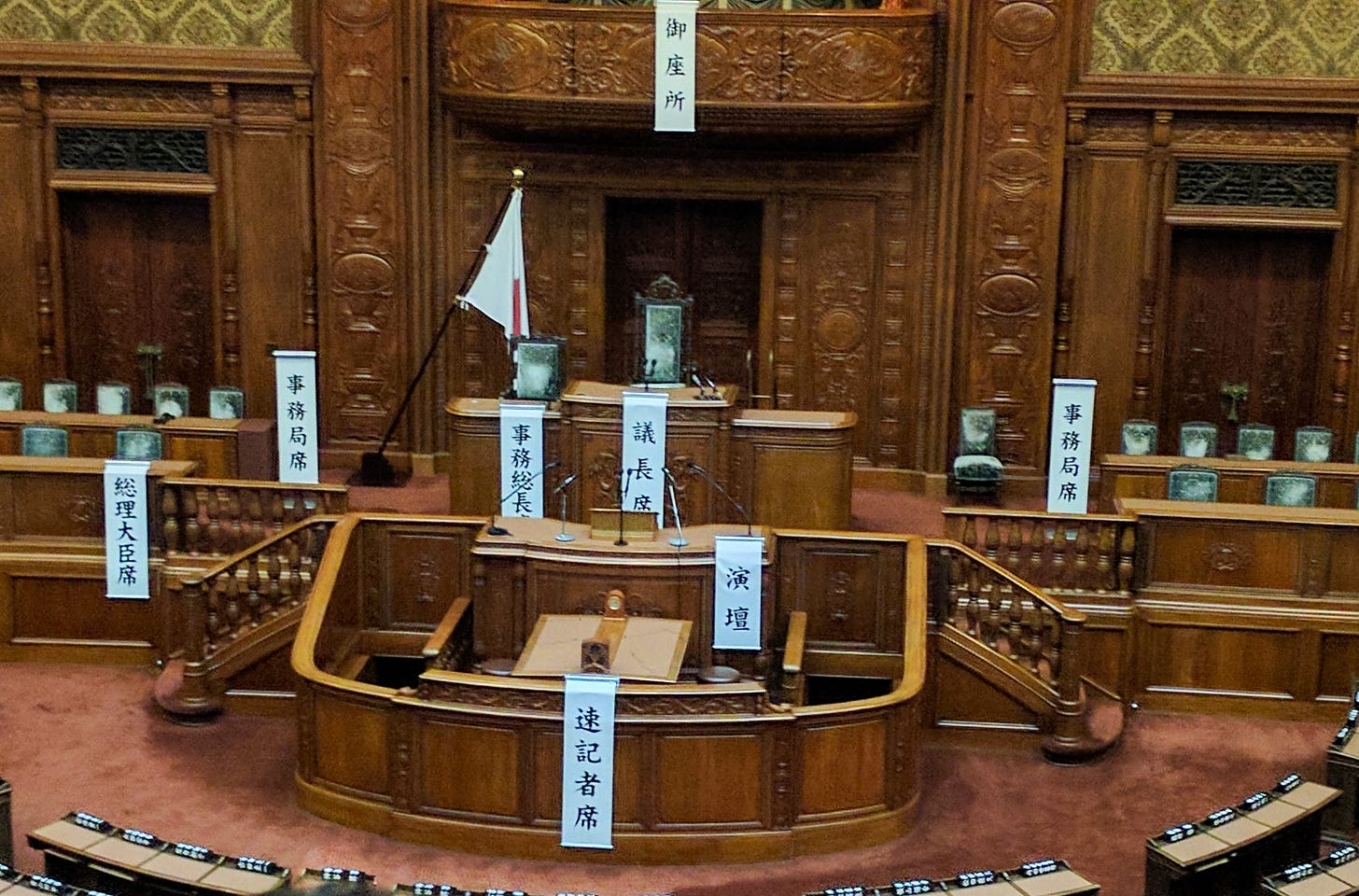How Japan Chooses Its Prime Minister
A simple guide to Japan’s top leader, elections, and the Emperor’s role

If you find this helpful, please tap the ♡ and share it with others😊🙏
日本(にほん)の国(くに)のリーダーのことを、首相(しゅしょう)といいます。
The leader of Japan is called the Prime Minister.
正式(せいしき)な名前(なまえ)は、内閣総理大臣(ないかくそうりだいじん)です。
The official title in Japanese is "Naikaku Sōri Daijin," which means "Prime Minister."
ふだんは、首相(しゅしょう)という短(みじか)い言(い)い方(かた)がよく使(つか)われます。
But people usually just say “Shushou” (Prime Minister) because it’s shorter.
どちらも同(おな)じ人(ひと)のことです。
Both words mean the same person.
首相(しゅしょう)は、国(くに)の政治(せいじ)をまとめる、一番(いちばん)えらい人(ひと)です。
The Prime Minister is the top person in charge of Japan’s government.
首相(しゅしょう)の選(えら)び方(かた)
How the Prime Minister is Chosen
日本(にほん)には、国会(こっかい)という政治(せいじ)の場所(ばしょ)があります。
Japan has a place for politics called the National Diet (Kokkai).
国会(こっかい)には、選挙(せんきょ)で国民(こくみん)に選(えら)ばれた人(ひと)たちがいます。
In the Diet, there are people chosen by the people in elections.
この人(ひと)たちは、国会議員(こっかいぎいん)とよばれます。
These people are called Diet members or lawmakers.
国会議員(こっかいぎいん)には、衆議院(しゅうぎいん)と参議院(さんぎいん)の二つがあります。
There are two houses: the House of Representatives and the House of Councillors.
衆議院(しゅうぎいん)は465人で、参議院(さんぎいん)は248人です(2025年現在(げんざい))
The House of Representatives has 465 members, and the House of Councillors has 248 members (as of 2025).
首相(しゅしょう)を決(き)めるときは、まず衆議院(しゅうぎいん)と参議院(さんぎいん)がそれぞれ別々(べつべつ)に投票(とうひょう)をして、首相(しゅしょう)にふさわしい人(ひと)をえらびます。
When choosing the Prime Minister, both houses vote separately to decide who is best for the job.
この投票(とうひょう)のことを、内閣総理大臣指名選挙 (ないかくそうりだいじんしめいせんきょ)といいます。
This is called the “Naikakusouridaijin Shimei Senkyo” in Japanese, which means the election to choose the Prime Minister.
もし、衆議院(しゅうぎいん)と参議院(さんぎいん)で同(おな)じ人(ひと)をえらんだときは、その人(ひと)が首相(しゅしょう)になります。
If both houses choose the same person, that person becomes the Prime Minister.
しかし、ちがう人(ひと)をえらんだときは、衆議院(しゅうぎいん)でえらばれた人(ひと)が首相(しゅしょう)になります。
But if they choose different people, the one chosen by the House of Representatives becomes Prime Minister.
これを、衆議院(しゅうぎいん)の優越(ゆうえつ)といいます。
This rule is called the “superiority of the House of Representatives.”
衆議院(しゅうぎいん)でたくさんの議席(ぎせき)を持(も)っている政党(せいとう)を、与党(よとう)といいます。
The political party with the most seats in the House of Representatives is called the ruling party (Yotou).
政党(せいとう)のリーダーのことを、党首(とうしゅ)といいます。
The leader of a political party is called a "toushu" in Japanese.
ふつうは、与党(よとう)の党首(とうしゅ)が、首相(しゅしょう)にえらばれます。
Usually, the party head of the ruling party becomes the Prime Minister.
国会(こっかい)で首相(しゅしょう)がえらばれたあとは、日本(にほん)の象徴(しょうちょう)である天皇(てんのう)が、その人(ひと)を正式(せいしき)に任命(にんめい)します。
After the Prime Minister is chosen by the Diet, Japan’s symbol, the Emperor, formally appoints the person.
天皇(てんのう)は政治(せいじ)の力(ちから)を持(も)っていませんが、首相(しゅしょう)を決(き)まったとおりに任命(にんめい)することになっています。
The Emperor has no political power but must appoint the Prime Minister as decided by the Diet.
首相(しゅしょう)の任期(にんき)
The Prime Minister’s Term
衆議院(しゅうぎいん)の任期(にんき)は4年(よねん)です。でも、ふつうは途中(とちゅう)で解散(かいさん)されることが多(おお)いです。参議院(さんぎいん)の任期(にんき)は6年(ろくねん)です。3年(さんねん)ごとに半分(はんぶん)ずつ入れかわります。
Members of the House of Representatives serve for 4 years. But the house is often dissolved early, so they usually don’t serve the full 4 years. Members of the House of Councillors serve for 6 years. But every 3 years, half of the members are replaced in an election.
首相(しゅしょう)には、きまった年数(ねんすう)の任期(にんき)はありません。
The Prime Minister does not have a fixed number of years to serve.
首相(しゅしょう)は与党(よとう)の党首(とうしゅ)です。
The Prime Minister is the head of the ruling party.
もし党首(とうしゅ)が病気(びょうき)になったり、自分(じぶん)でやめたり、人気(にんき)がなくなったりして変(か)わったとき、新(あたら)しい党首(とうしゅ)が首相(しゅしょう)になります。
If the party head becomes sick, steps down, or loses support, a new party head becomes the next Prime Minister.
たとえば、安倍晋三(あべしんぞう)首相(しゅしょう)が病気(びょうき)でやめたとき、同(おな)じ与党(よとう)である自民党(じみんとう)の菅義偉(すがよしひで)さんが新(あたら)しい党首(とうしゅ)になり、首相(しゅしょう)になりました。
For example, when Prime Minister Abe Shinzo resigned due to illness, Suga Yoshihide from the same party, the Liberal Democratic Party, became the new party head and then the Prime Minister.
首相(しゅしょう)の仕事(しごと)
The Prime Minister’s Job
首相(しゅしょう)は、国(くに)の政治(せいじ)をまとめます。
The Prime Minister leads the country’s politics.
内閣(ないかく)というチームをつくり、大臣(だいじん)を選(えら)びます。
They form a team called the Cabinet and choose ministers.
国会(こっかい)で話(はな)し合(あ)いをしたり、法律(ほうりつ)を出(だ)したりします。
They speak in the Diet and propose new laws.
外国(がいこく)のリーダーと会(あ)って、話(はな)すこともあります。
They also meet with leaders from other countries.
また、国民(こくみん)の生活(せいかつ)をよくするために、大切(たいせつ)なことを決(き)めていきます。
They make important decisions to help improve people’s lives in Japan.

